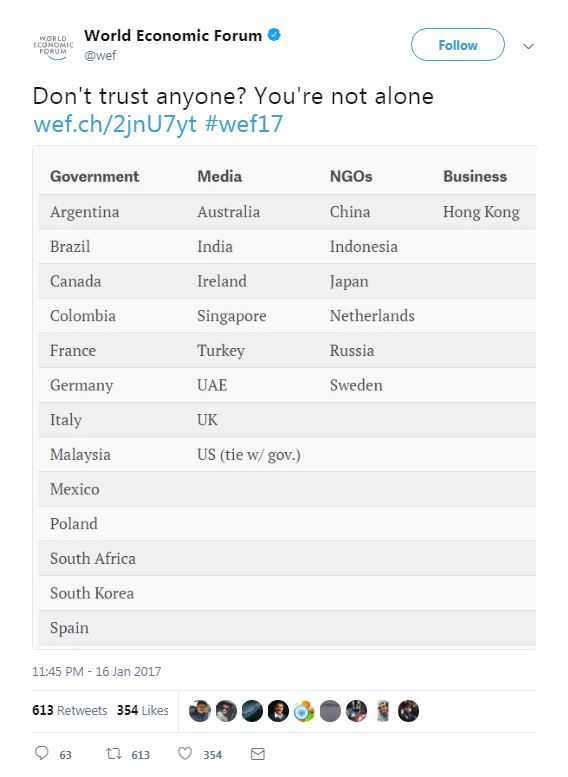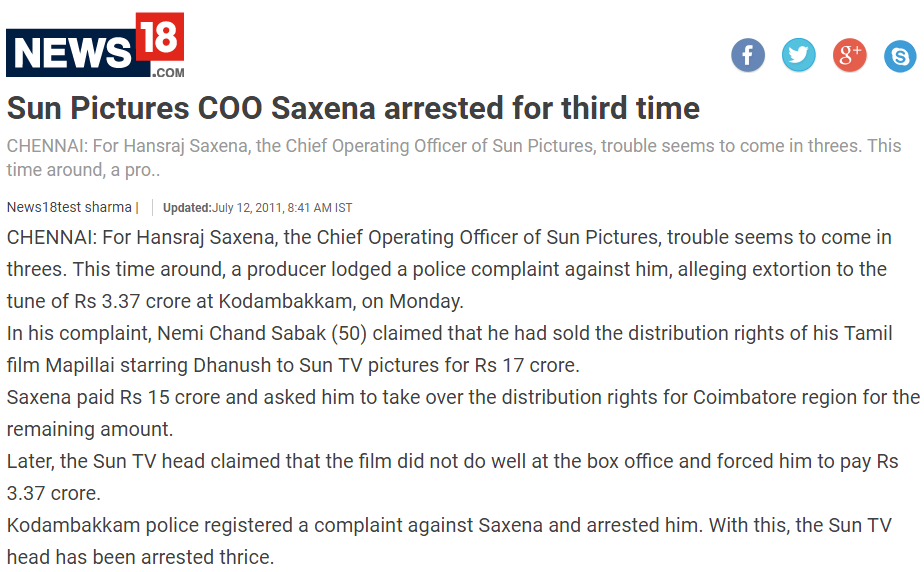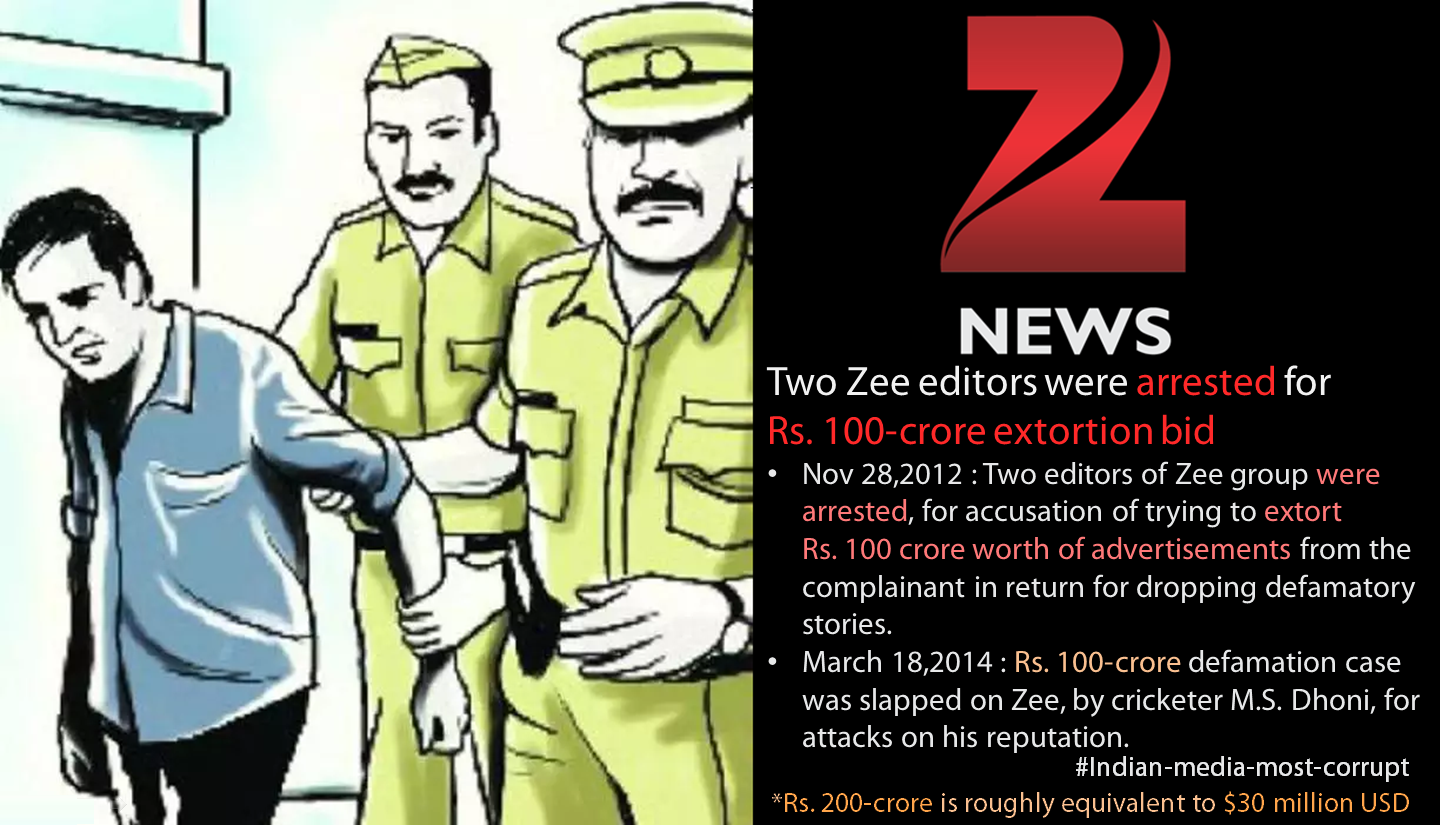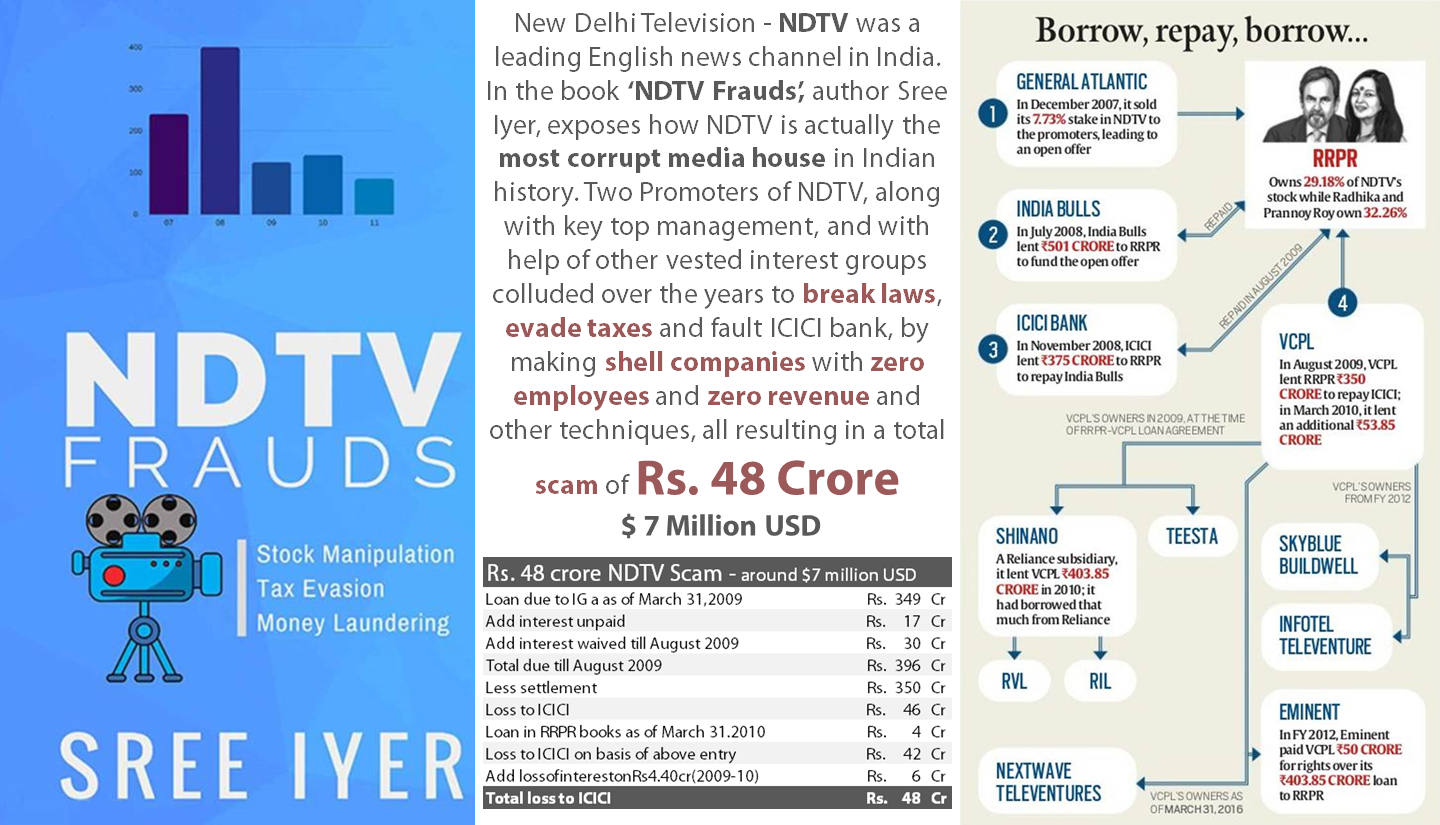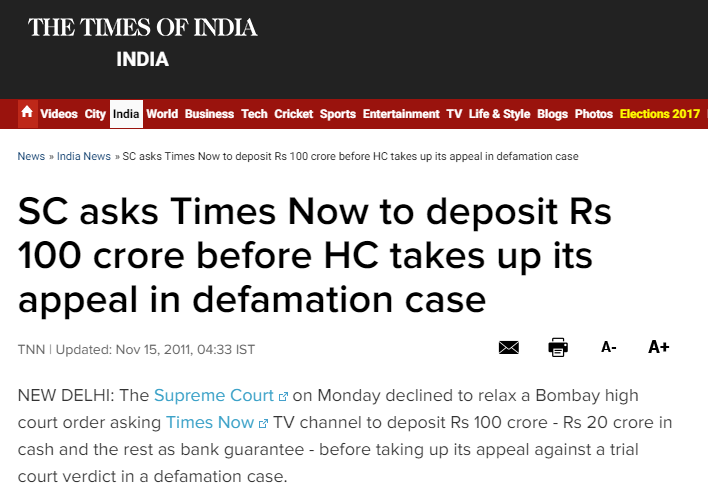Horrifying revelations about Indian Media: instances of its unscrupulous involvement in financial, criminal, civil and sexual crimes in an organised attempt to destabilize the nation. This fact was consolidated by World Economic Forum which has recently tweeted Indian media is as the most corrupt media in the world.
Diabolical involvement of Indian Media
The existence of corruption in Indian media has been exposed time and again by various governmental and non-governmental agencies, both nationally and internationally. In this article, we explore the appalling extent to which Indian media houses have got involved in diabolical means. (1) anti-national activities, (2) extortion, (3) sexual-assault & rape, (4) child molestation and child rape, (5) child exploitation, (6) paid news, (7) criminal intimidation, (8) money laundering, (9) blackmail, (10) illicit-black-money, (11) criminal misappropriation, (12) conspiracy, (13) sexual harassment, (14) fraud, (15) shady foreign shell companies, (16) unclear beneficial ownership, (17) financial malpractices, (18) defamation etc.
Contents
- Indian media is most corrupt media – World Economic Forum Tweets Edelman Report
- Indian Media houses and media-men: Cases of corruption, financial, criminal, civil and sexual crimes against them
- Sun TV – corruption, sexual harassment, criminal intimidation, paid news, fraud, money laundering, extortion, blackmailing, illicit-black-money etc.
- Zee News – extortion, blackmailing, paid news, illicit-black-money.
- NDTV – anti-national, illicit-black-money, shady foreign shell companies, unclear beneficial ownership, financial frauds.
- National Herald – criminal misappropriation, financial malpractices
- Times Now – paid news
- Janasri TV – Kannada Channel – extortion, blackmailing.
- Samaya News – extortion, blackmailing, criminal intimidation, conspiracy, child molester accomplice, paid-news
- Aaj Tak – paid news, election result influencing, child exploitation
- Tarun Tejpal – rape and sexual assault
- Electronic media acts like it has become Pope overnight: Chief Justice of Supreme Court
- Paid Media undermining democracy – Reports by statutory constitutional agencies
- Who owns the media
Indian media is most corrupt media – World Economic Forum Tweets Edelman Report
The World Economic Forum was established in 1971 as a not-for-profit foundation in Geneva, Switzerland. It aims to be independent, impartial and not tied to any special interests. On 16 Jan 2017, The World Economic Forum tweeted a screenshot of a survey showing Indian media as the #2 most corrupt media[i][ii][iii].
In recent years, media has turned out to be one of the most corrupt institutions with absolutely no ethics or responsibility. The India media has completely lost their credibility.
The Edelman report has labeled the Indian media as the second most untrusted institution in the world. The survey showed that the trust of people in media was an all-time low and the credibility and motive of these institutions have been under question.
Trust deficit – Global Implosion in trust
The emergence of social media was the main reason, the hypocrisy of the media got exposed. It got exposed that the people who call themselves journalists had actually turned into working for money and were driven by vested interests. Majority of people have expressed displeasure over the media reports. The report said that the people expect the media to reflect the opinion and voice of the unheard, but people feel that they cannot trust the media content anymore as most of them have found it to be driven by vested interest and aimed to exploit the situation for gaining TRPs. The report said that overall there has been a “global implosion” in trust – a total trust deficit.
A total of 28 countries were surveyed, out of which 17 countries expressed their mistrust on the media, Indian media was seen as the second most corrupt. It is definitely not a surprise, given the fact how Indian journalists have used silly issues and blown it out of proportion to create panic among people. Several issues have been scripted by media and presented as news and facts. These have aggravated the society, the common man. Indian media has also been building a narrative against the country by showing anti-national characters in a positive light and anti-national thought currents as the best way to think. The media would create fake issues, and start jumping over these fake stories, attempting to create an uproar in the society.
It is absolutely true that there is no trust in media and the news channels have turned out to be a gossip box, with people ranting nonsense 24 hours. The mainstream media has already lost relevance with the emergence of social media. The best examples are how NDTV viewership has fallen below 2% especially after their anti-national stand. NDTV alleged that the TV ratings had been manipulated and sued the country’s only television audience measurement company[iv][v].
[i] https://twitter.com/wef/status/821058226527629314
[ii] https://www.weforum.org/agenda/2017/01/dont-trust-anyone-youre-not-alone
[iii] http://www.nagpurtoday.in/indian-media-is-most-corrupt-with-no-ethics-and-responsibility-world-economic-forum-survey/03061040
[iv] http://www.thehindu.com/news/national/ndtv-says-tv-ratings-manipulated/article3708627.ece
[v] http://www.indiantelevision.com/television/tv-channels/news-broadcasting/the-rise-and-fall-of-english-news-tv-viewership-171121
Indian Media houses and media-men: Cases of corruption, financial, criminal, civil and sexual crimes against them
Sun TV
Sun TV Network runs the most popular Tamil language satellite television channels in the world. It was started on 14 April 1992 by Kalanidhi Maran. At one point, Sun TV was the most viewed entertainment channel in India, as per BARC report.
The channel has the history of corruption, sexual harassment, criminal intimidation, paid news, fraud, money laundering, extortion, blackmailing, illicit-black-money etc. Few of them are listed below:
- April 2015: In Aircel-Maxis case Rs. 742 Crore worth of property of Sun TV and owner Kalanidhi Maran was impounded by the Enforcement Directorate for money laundering based on a CBI report.
- July 2011: Sun TV COO Hansraj Saxena was arrested thrice for various cases of extortion and blackmailing.
- After one of his arrests, Sun TV COO Hansraj Saxena confessed on a written affidavit and on TV that the channel had created the morphed video of His Holiness Paramahamsa Nithyananda and actress Ranjitha for the purpose of extortion.
- Jan 2015: The next COO of Sun TV, C Praveen, was also arrested on sexual harassment complaints filed by a former staff of the television network.
- By far the biggest known crime done by the channel was its involvement in 2G spectrum scam which resulted in a loss of Rs. 17,60,00,00,00,000/- (roughly equivalent to $30 Billion USD ) to the public exchequer.

In Aircel-Maxis case Rs. 742 Crore worth of property of Sun TV and owner Kalanidhi Maran was impounded by the Enforcement Directorate for money laundering based on a CBI report.
Sun TV COO Hansraj Saxena was arrested thrice for various cases of extortion and blackmailing.
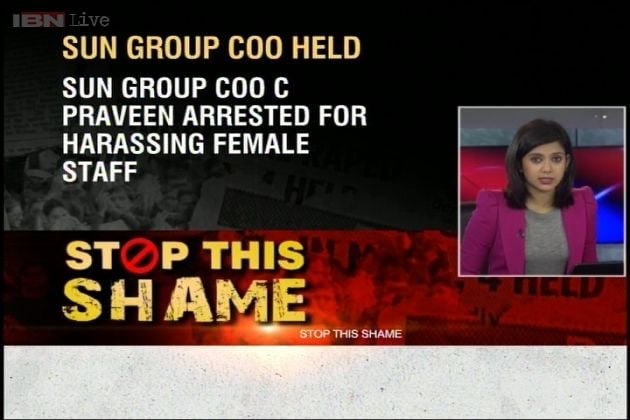
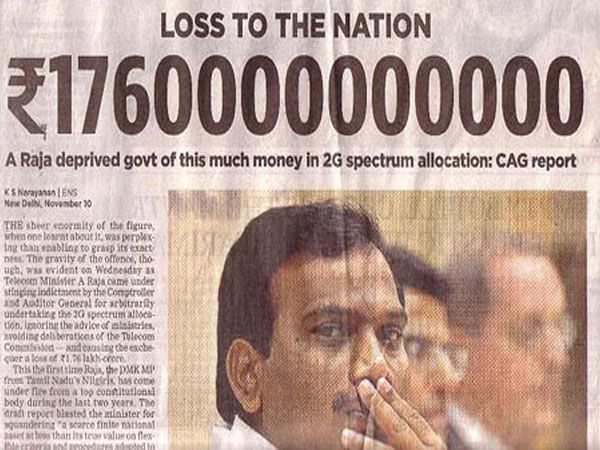
By far the biggest known crime done by the channel was its involvement in 2G spectrum scam which resulted in a loss of
Rs. 17,60,00,00,00,000/- (roughly equivalent to $30 Billion USD ) to the public exchequer.
Zee News
Two Zee editors were arrested for ‘Rs 100-crore extortion bid’ (equivalent to $15 million USD)
Nov 28, 2012: Delhi Police’s crime branch arrested two editors of the Zee group on Tuesday, who were accused of extortion. The editors were accused of trying to extort Rs 100 crore worth of advertisements from the company of the complainant in return for dropping stories.
https://timesofindia.indiatimes.com/india/Two-Zee-editors-arrested-for-Rs-100-crore-extortion-bid/articleshow/17391903.cms
Another defamation case of Rs 100 crore suit on Zee
March 18, 2014: A Rs. 100-crore defamation case was slapped on Zee, by famous Indian cricketer Mr. M.S. Dhoni, for attacks on his reputation.
https://timesofindia.indiatimes.com/news/MS-Dhoni-slaps-Rs-100-crore-suit-on-Zee/articleshow/32236289.cms
NDTV
Biased and corrupt, anti-national news channel, NDTV, had already a controversial history of disclosing the location of Indian Army along with artillery to Pakistani forces during times of war. New Delhi Television – NDTV was a leading anti-national news channel in India. NDTV viewership has fallen below 2% especially after their anti-national stand. NDTV alleged that the TV ratings had been manipulated and sued the country’s only television audience measurement company. Even in spite of such boycott by the Indian household, one wonders how still the company continues to flourish. The secret is revealed by studying the financial frauds and scams done by the channel.
NDTV Frauds
In the book ‘NDTV Frauds’, author Sree Iyer, exposed how NDTV was actually one of the the most corrupt media house in Indian history. Two Promoters of NDTV, the top management, and other vested interest groups colluded over the years to break laws, evade taxes and fault ICICI bank, by making shell companies with zero employees and zero revenue and other techniques, all resulting in a total financial scam of Rs. 48 Crore ($ 7 Million USD).
One is left wondering what right media channels have to pretend to be neutral, ethical, unbiased, ‘voice of the common man’. After all their scams, various news channels unite to protect NDTV from public scrutiny. The media claimed that the entire legal proceedings and investigations initiated against NDTV by families of shareholders of ICICI bank which suffered a loss of Rs. 48 crore was a witch hunt against innocent media houses. NDTV had siphoned money through a complex network of shell companies and other illicit financial tricks.
National Herald
National Herald is an Indian newspaper published by The Associated Journals Ltd, owned by a major political party of the country. It was started in 1938. After independence, the newspaper was briefly shut down in the 1940s and 70s. Owing to financial crunch, the operations were temporarily stopped in 2008. In 2016, the board of directors of Associated Journals Limited (AJL) took the decision of relaunching the newspaper.
National Herald Scam – Young Indian
A case in a Delhi court was filed by an Indian economist and politician against the owner politicians, their companies, and associated persons.[1] As per the complaint filed in the court of the Metropolitan Magistrate, the ruling party granted an interest-free loan of Rs. 90.25 crore (US$14 million) to Associated Journals Limited (AJL), owner of the National Herald newspaper. It was alleged that the loan was either not repaid or repaid in cash, which is in violation of Section 269T of the Income Tax Act, 1961.[2] A closely held company, Young Indian, was incorporated in November 2010 with a capital of Rs. 50 lakh(US$78,000) and it acquired almost all the shareholding of AJL and all its properties (alleged to be worth Rs. 5,000 crores (US$780 million)).[3] The complainant alleged criminal misappropriation by the owners. The courts have determined that a prima face case has been established in the matter.
After the Delhi High Court dismissed the appeal of the owners and others against the summons issued by the trial court, many shareholders of AJL have alleged that no notice was served on them by AJL for any meeting of the shareholders and that the shares held by their fathers have been transferred by AJL to Young Indian fraudulently without their consent in December 2010. These include people such as former law minister and former chief justice of Allahabad and Madras High Courts.[11]
Times Now
On September 10, 2008, Times Now had aired a false news and there was a suit for Rs. 100 crore (equivalent to $15 Million USD) against the TV channel. The channel tried to escalate the matter to Supreme Court and appealed to save the channel from Bombay High Court order of paying Rs. 20 crore cash deposit and Rs. 80 crore bank guarantee. The Supreme Court denied.
What the reader wonders is how these channels continue to survive and even flourish after multi-crore, multi-million dollar scams.
Janasri TV – Kannada Channel
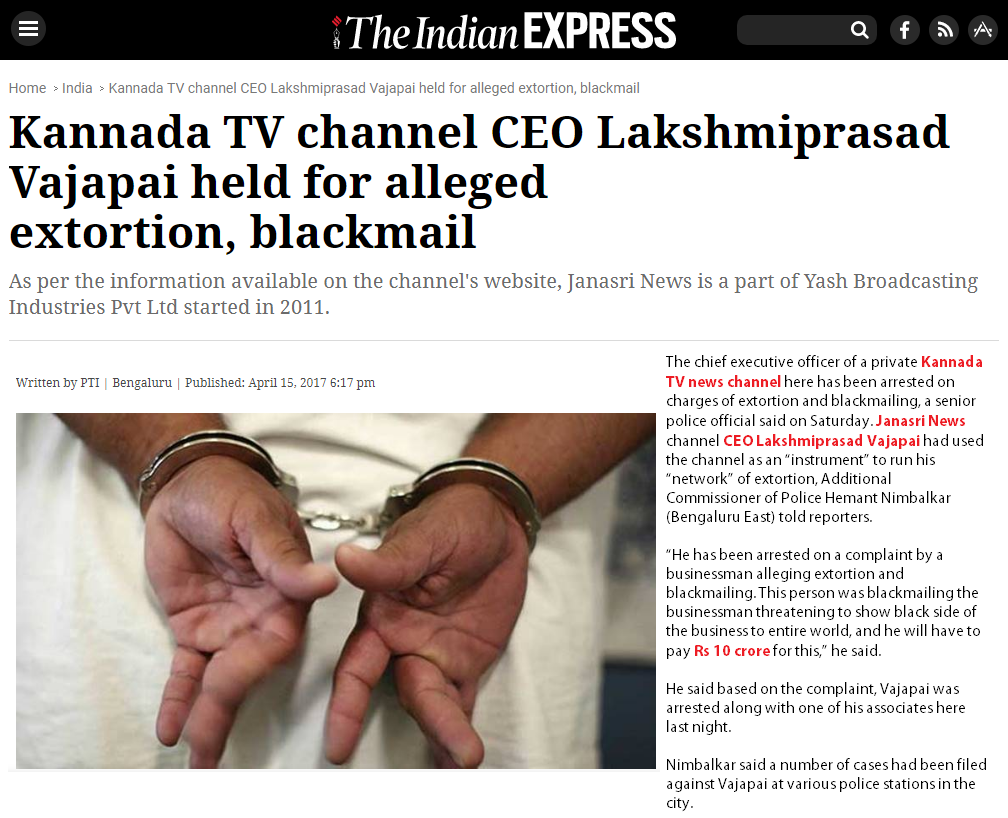
In April 2017 the chief executive officer of a private Kannada TV news channel, Janasri News was arrested on charges of extortion and blackmailing. As per the Police,
- The channel CEO Lakshmiprasad Vajapai had used the channel as an “instrument” to run his “network” of extortion.
- The CEO was arrested on a complaint by a businessman alleging extortion and blackmailing. The CEO was blackmailing the businessman threatening to give an undesired representation of the complainant’s business to the entire world and tried to extort Rs 10 crore.
- CEO Lakshmiprasad followed a fixed modus operandi. He would first identify a businessman, dig out information on the businessman and prepare a news item. He would then broadcast only a portion of this negative content and proceed to contact the “victim.” Lakshmiprasad would then demand money in return for not airing the full episode.
- A number of cases had been filed against Vajapai at various police stations in the city. There are two more similar cases against Lakshmiprasad at Commercial Street and Mahalakshmipuram Police Stations. Where according to the complaint registered, he has already taken Rs 10 crore from a businessman along with Rs. 30 lakh worth gold jewelery.
- The company is said to be formed by people who have 3 decades of experience in this field.
Samaya News
Samaya TV is a television news channel, launched on 20 June 2010. Within a year of launch, Samaya News 24X7 became the second-most viewed news channel in Karnataka.
Throughout 2012 to 2017 the channel chief reporter Ranganath Bharadwaj conspired with child molester Vinay Bharadwaj (who was fined $ 1/2 Million USD for repeated counts of child molestation) to attack His Divine Holiness Paramahamsa Nithyananda. In this desperate attempt, the channel even attacked the U.S.A. courts with false defamatory news programs which ran in 1000 hours total.
The Kannada news television channel Samaya TV and chief reporter Ranganath Bharadwaj were found guilty of defamation and civil conspiracy by USA Court. In Dec 2017, the USA Court fined them with a $5 Million (equivalent to Rs. 32 Crore ) judgement for broadcasting false news about His Divine Holiness Paramahamsa Nithyananda and his USA mission. As of now all other major legal proceedings against media houses filed by various entities throughout the country are pending disposal. This has thus been the single biggest major victory against a paid news channel in the history of India.
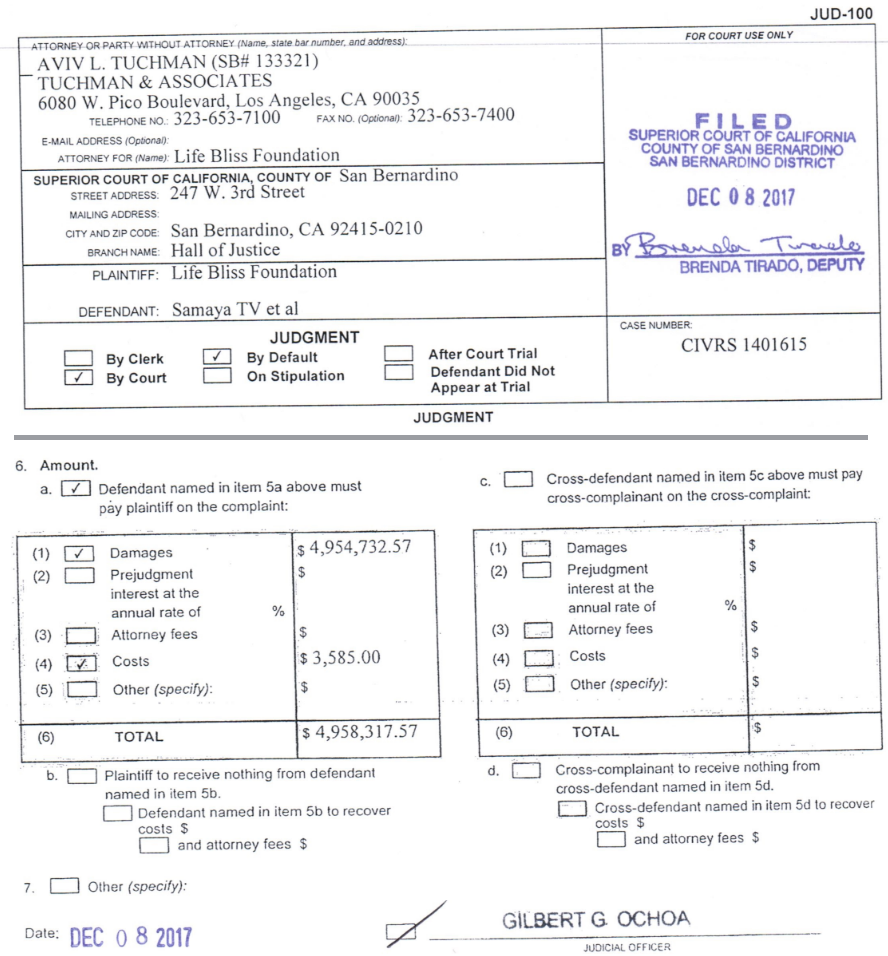
Samaya TV and chief reporter Ranganath Bharadwaj were fined $5 Million USD (equivalent to Rs. 32 Crore ) making this the biggest single penalty on an Indian News House.
Aaj Tak
Anti-national Aaj Tak was once the most popular Hindi language Indian news channel. The channel has been accused of journalistic Hinduphobia and selective misrepresentation of Hindu festivals and rituals. The Election Commission is reported to have identified more than 1,400 cases of paid news between 2009 and 2013, during which elections were held in 17 states of India.[7][814 April 1992 ] One such incident happened on February 2014 where the unholy alliance of the channel (media) and with other vested groups to got exposed on social media and people fed up with the volumes of paid, biased and irrelevant news by the channel made hashtags like #UnlikeAajtak #StopWatchingAAJTAK go viral. The channel lost 300,000 likes on its social media pages in a single day.
The records of the event can be seen on social media websites:
https://www.facebook.com/hashtag/UnlikeAajtak
https://www.facebook.com/hashtag/stopwatchingaajtak
Child Exploitation and Liquor Bribe
In November 2015, a video came online showing an Aaj Tak reporter bribing a kid with money to purchase liquor in order to convince him to give a negative statement as per the channel’s vested interest.[1][2]
This was met with widespread criticism.
 |
 |
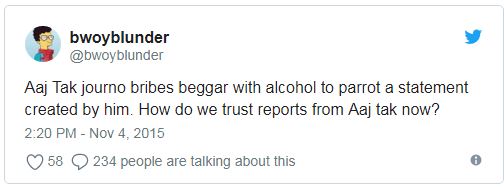 |
 |
Convicted rapist journalist – Tarun Tejpal
Tarun Tejpal is an Indian journalist, publisher, novelist and former editor-in-chief of Tehelka magazine. In November 2013, he stepped down as editor for six months after a female colleague accused him of sexual assault and rape. He was arrested on 30 November 2013 and is currently on bail since 1 July 2014. It is particularly eerie to note that it is the same Tejpal who had previously been involved in highlighting the issue of sexual violence in India. One cannot miss noticing the double standards of Indian media, which shows smallest of false cases against others as a big scandal and hide their own dirty stories of sexual and financial crimes.
Rajdeep Sardesai – Times of India
Dilip Sardesai father of Rajdeep Sardesai (journalist, editor Times of India) was arrested by Mumbai police in 1993 in connection with Foreign Exchange Regulation Act violations, involving $6.89 Million USD.
In 2012, Rajdeep Sardesai had denied to report killing of 21 Hindus during Assam Riots, saying he would report only if more than 1000 were killed.
Sardesai had denied to report killing of 21 Hindus during Assam Riots in 2012, saying if more than 1000 are killed then he will report. pic.twitter.com/yTHJiLINYO
— प्रशान्त पटेल उमराव (@ippatel) February 6, 2018
Electronic media acts like it has become Pope overnight: Chief Justice of Supreme Court
16th March 2018: Chief Justice Dipak Misra Slams Electronic Media, Says They Need To Be More Responsible – “We respect freedom of the press but it has to act responsibly. Electronic media can’t think they become Popes overnight.” A three-judge bench, headed by Chief Justice of India Dipak Misra was hearing the plea filed by The Wire seeking to quash criminal defamation case against the news portal.

Paid news undermining democracy: Press Council report
The Press Council of India is a statutory body in India that governs the conduct of the print media. It is one of the most important bodies that sustain democracy, as it has supreme power in regard to the media to ensure that freedom of speech is maintained. It is also empowered to hold hearings on receipt of complaints and take suitable action where appropriate.
Paid news is a phenomenon in Indian media, that refers to the systematic engagement of mainstream media outlets in publishing favorable articles in exchange for payment.[1][2] This type of news is typically sponsored by vested interest groups to accomplish their personal goals.
Throughout 2009 and even today, Press Council of India, had been receiving several complains from citizens of India about the menace of paid news. Press Council of India compiled its report for next four years period and in 2013 presented its report. In 2013, the Press Council of India report was submitted to Parliament by the Standing Committee on Information Technology.
The report, which points out that self-regulation by India’s media has failed to stop the practice of paid news, has some eye-catching recommendations. It suggests a more-powerful regulator and stiffer penalties, including criminal charges, possibly leading to imprisonment, for those who accept payment for news.
Election Commission of India Report
The Election Commission is reported to have identified more than 1,400 cases of paid news between 2009 and 2013, during which elections were held in 17 states of India.[7][8]
The rise of ‘Paid News’, the report says, “has undermined the essence of a democratic process.”
But the document, submitted to the Lok Sabha on May 6, 2013, generated little media coverage (Here’s one of the few reports.)
The committee report, noting the issue of paid news has been a feature of the media landscape since the 2009 national election, said it was “astonishing that a large section of the media is completely silent on this malpractice“.
Securities and Exchange Board of India – Report on Indian Media Groups attempt of securities price manipulation and influencing
The Securities and Exchange Board of India (SEBI) is the regulator for the securities market in India. It was established in the year 1988 and given statutory powers on 30 January 1992 through the SEBI Act, 1992. The SEBI in a letter in context of Press Council Report on paid-news warned that
“Private Treaties may lead to commercialisation of news reports since the same would be based on the subscription and advertising agreement entered into between the Media group and the company. Biased and imbalanced reporting may lead to inaccurate perceptions of the companies which are the beneficiaries of such private treaties.”
Complete original report is accessible from here: http://www.indiatogether.org/uploads/document/document_upload/2146/PCIsc-intro.pdf
Radiya tapes – Indian Income Tax department Report
The Radia tapes controversy relates to the telephonic conversations between Nira Radia, an influence peddler and with senior journalists, taped by the Indian Income Tax Department in 2008–09.
After getting authorization from the Home Ministry, the Indian Income Tax department[6] tapped Radia’s phone lines for 300 days[7] in 2008–2009 as part of their investigations into possible money laundering, restricted financial practices, and tax evasion.
In November 2010, OPEN magazine[8] carried a story which reported transcripts of some of the telephone conversations of Nira Radia with senior journalists, many of whom have denied the allegations.[9] The Central Bureau of Investigation has announced that they have 5,851 recordings of phone conversations by Radia, some of which outline Radia’s attempts to broker deals in relation to the 2G spectrum sale.[10] The tapes appear to demonstrate how Radia attempted to use some media persons to influence the government decisions.[11]
The news gained prominence following sustained pressure on social networking sites Twitter[21][22] and Facebook[23] against an attempted blackout orchestrated by many prominent Indian TV channels and newspapers.[15][24][25]
Journalists mentioned in the Radia tapes
- Barkha Dutt, Group editor, English news, New Delhi Television(NDTV), NDTV also has a Hindi news channel NDTV India
- M.K. Venu, then Opinion Editor, The Economic Times. Outlook weekly published unconditional apology for naming M.K.Venu on its cover.
- Prabhu Chawla,[1][14] the then editor of India Today magazine
- Shankar Aiyar, then with India Today Group
- Vir Sanghvi, HT advisory editorial director
- Casual conversations with Radia of Editors of The Times of India, The Economic Times and The Hindu Businessline also figured in the tapes published by Outlook magazine.
Who owns the media?
Since 2009 many blog-articles came out trying to explain why Indian Media is biased. Some of them tried to figure out the beneficial ownership of various media houses.
As already seen in the case of NDTV Frauds section, fake shell companies (with zero employees) are used for financing media houses and their illegal activities.
As presented along with rigorous case studies, Treasure Islands: Tax Havens and the Men Who Stole the World, author Nicholas Shaxson, explained how the beneficial ownership of various companies is convoluted by financial jugglery like – purchasing each other’s stocks and operating through offshore shell companies based out of the country, protected by secrecy laws.
Therefore we see several claims on social media and blogs alleging that anti-national activities of media are sponsored by foreign entities and their respective religious affiliations being pushed for anti-Hindu atrocity news generation for their vested interest.


